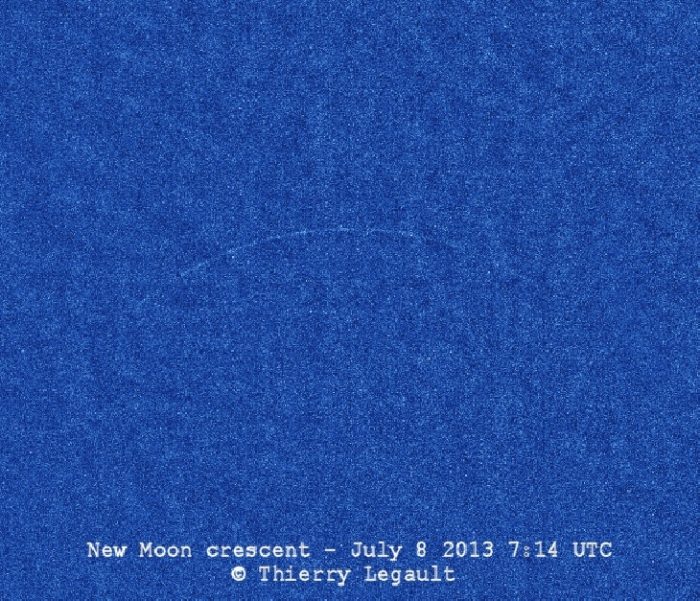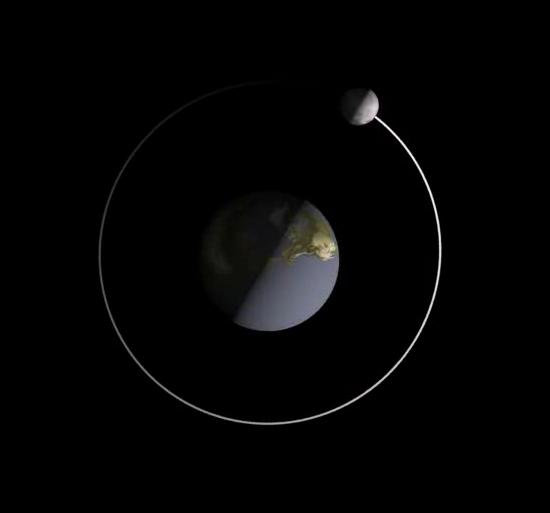

Youngest possible lunar crescent, with the moon’s age being exactly zero when this photo was taken – at the instant of new moon – 07:14 UTC on July 8, 2013. Image by Thierry Legault.
New moon falls on Monday, December 14, 2020, at 16:16 UTC. That’s 10:16 a.m. CST. Translate UTC to your time.
When the moon is new, it’s most nearly between the Earth and sun for any particular month. It’s rising and setting when the sun does and traveling across the sky with the sun during the day.
There’s a new moon about once a month, because the moon takes about a month to orbit Earth. Most of the time, the new moon passes not in front of the sun at new moon, but only near the sun in our sky. That’s why, in most months, there’s no solar eclipse.
The photo of a new moon at the top of this page shows the moon as it passed near the sun on July 8, 2013. There was no eclipse that day; it was an ordinary new moon.
New moons typically can’t be seen, or at least they can’t without special equipment and a lot of moon-photography experience. Thierry Legault was able to catch the photo at top – the moon at the instant it was new – because the moon that month passed to one side of the sun, and the faintest of lunar crescents was visible.

Click here to see animation. As seen from the north side of the moon’s orbital plane, the Earth rotates counterclockwise on its rotational axis, and the moon revolves counterclockwise around Earth. In the linked animation note that the new moon happens when the moon is on the same side of Earth as the sun.
Some people use the term new moon for a thin crescent moon visible in the west after sunset. You always see these little crescents – which set shortly after the sun – a day or two after each month’s new moon. Astronomers don’t call these little crescent moons new moons, however. In the language of astronomy, this slim crescent is called a young moon.
New moons, and young moons, are fascinating to many. The Farmer’s Almanac, for example, still offers information on gardening by the moon. And many cultures have holidays based on moon phases.
Bottom line: New moons generally can’t be seen. They cross the sky with the sun during the day. This month’s new moon happens on December 14 at 16:16 UTC. Afterward – beginning around December 16 – the moon will return to the evening sky.
Read more: What’s the youngest moon you can see?
Read more: Top 4 keys to understanding moon phases
Help EarthSky keep going! Please donate.
from EarthSky https://ift.tt/2QpMvsB


Youngest possible lunar crescent, with the moon’s age being exactly zero when this photo was taken – at the instant of new moon – 07:14 UTC on July 8, 2013. Image by Thierry Legault.
New moon falls on Monday, December 14, 2020, at 16:16 UTC. That’s 10:16 a.m. CST. Translate UTC to your time.
When the moon is new, it’s most nearly between the Earth and sun for any particular month. It’s rising and setting when the sun does and traveling across the sky with the sun during the day.
There’s a new moon about once a month, because the moon takes about a month to orbit Earth. Most of the time, the new moon passes not in front of the sun at new moon, but only near the sun in our sky. That’s why, in most months, there’s no solar eclipse.
The photo of a new moon at the top of this page shows the moon as it passed near the sun on July 8, 2013. There was no eclipse that day; it was an ordinary new moon.
New moons typically can’t be seen, or at least they can’t without special equipment and a lot of moon-photography experience. Thierry Legault was able to catch the photo at top – the moon at the instant it was new – because the moon that month passed to one side of the sun, and the faintest of lunar crescents was visible.

Click here to see animation. As seen from the north side of the moon’s orbital plane, the Earth rotates counterclockwise on its rotational axis, and the moon revolves counterclockwise around Earth. In the linked animation note that the new moon happens when the moon is on the same side of Earth as the sun.
Some people use the term new moon for a thin crescent moon visible in the west after sunset. You always see these little crescents – which set shortly after the sun – a day or two after each month’s new moon. Astronomers don’t call these little crescent moons new moons, however. In the language of astronomy, this slim crescent is called a young moon.
New moons, and young moons, are fascinating to many. The Farmer’s Almanac, for example, still offers information on gardening by the moon. And many cultures have holidays based on moon phases.
Bottom line: New moons generally can’t be seen. They cross the sky with the sun during the day. This month’s new moon happens on December 14 at 16:16 UTC. Afterward – beginning around December 16 – the moon will return to the evening sky.
Read more: What’s the youngest moon you can see?
Read more: Top 4 keys to understanding moon phases
Help EarthSky keep going! Please donate.
from EarthSky https://ift.tt/2QpMvsB

Aucun commentaire:
Enregistrer un commentaire